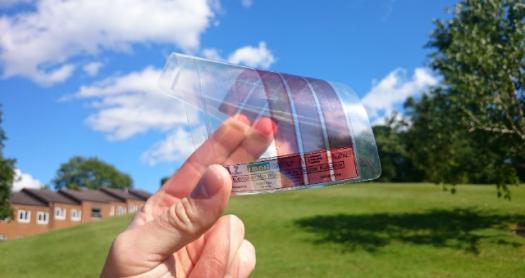New research unveils graphene "˜moth eyes' to power future smart technologies

New ultra-thin, patterned graphene sheets will be essential in designing future technologies such as "˜smart wallpaper' and internet-of-things applications
New research published in Science Advances has shown how graphene can be manipulated to create the most light-absorbent material for its weight, to date. This nanometre-thin material will enable future applications such as "˜smart wallpaper' that could generate electricity from waste light or heat, and power a host of applications within the growing "˜internet of things'.
Using a technique known as nanotexturing, which involves growing graphene around a textured metallic surface, researchers from the University of Surrey's Advanced Technology Institute took inspiration from nature to create ultra-thin graphene sheets designed to more effectively capture light. Just one atom thick, graphene is very strong but traditionally inefficient at light absorption. To combat this, the team used the nano-patterning to localise light into the narrow spaces between the textured surface, enhancing the amount of light absorbed by the material by about 90 percent.
Technology inspired by nature
"Nature has evolved simple yet powerful adaptations, from which we have taken inspiration in order to answer challenges of future technologies," explained Professor Ravi Silva, Head of the Advanced Technology Institute.
"Moths' eyes have microscopic patterning that allows them to see in the dimmest conditions. These work by channelling light towards the middle of the eye, with the added benefit of eliminating reflections, which would otherwise alert predators of their location. We have used the same technique to make an amazingly thin, efficient, light-absorbent material by patterning graphene in a similar fashion."
Graphene has already been noted for its remarkable electrical conductivity and mechanical strength. Professor Ravi's team understood that for graphene's potential to be realised as material for future applications, it should also harness light and heat effectively.
Professor Silva commented: "Solar cells coated with this material would be able to harvest very dim light. Installed indoors, as part of future "˜smart wallpaper' or "˜smart windows', this material could generate electricity from waste light or heat, powering a numerous array of smart applications. New types of sensors and energy harvesters connected through the Internet of Things would also benefit from this type of coating."
Nanotexturing for smart technologies
Dr José Anguita of the University of Surrey and lead author of the paper commented: "As a result of its thinness, graphene is only able to absorb a small percentage of the light that falls on it. For this reason, it is not suitable for the kinds of optoelectronic technologies our "˜smart' future will demand."
"Nanotexturing graphene has the effect of channelling the light into the narrow spaces between nanostructures, thereby enhancing the amount of light absorbed by the material. It is now possible to observe strong light absorption from even nanometre-thin films. Typically a graphene sheet would have 2-3 percent light absorption. Using this method, our ultrathin coating of nanotextured few-layer graphene absorbs 95 percent of incident light across a broad spectrum, from the UV to the infrared."
Professor Ravi Silva noted: "The next step is to incorporate this material in a variety of existing and emerging technologies. We are very excited about the potential to exploit this material in existing optical devices for performance enhancement, whilst looking towards new applications. Through Surrey's EPSRC funded Graphene Centre, we are looking for industry partners to exploit this technology and are keen to hear from innovative companies who we can explore the future applications of this technology with us."

































